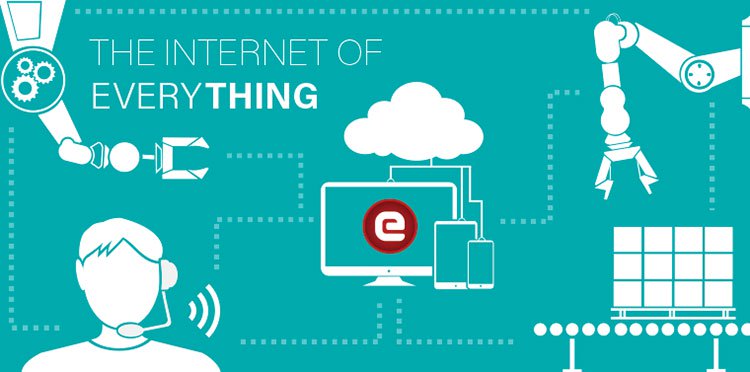
Making Sense of "All the Things"
Lauren Noyes | 05 July 2016
The ‘Internet of Things’ has been upgraded to the ‘Internet of Everything’ in the material handling industry.
The Internet of Things (IoT) is the network of physical objects – devices, vehicles, buildings – embedded with electronics, sensors, and software with network connectivity to exchange data. RF scanning devices, conveyor photo eyes, and warehouse management software are a few of the elements that contribute to the warehouse IoT. Take the concept a step further by mining data from the operation to feed business intelligence software and you have the Internet of Everything (IoE). This overarching phrase describes adding intelligence to every device to give it a function.
The IoE analyzes people, data, things, and processes to suggest proactive plans, essentially functioning as a warehouse analyst at lightning speed. The Fitbit, cell phone, or smart watch you wear connects you to the IoE. Like it or not, it gathers and analyzes the steps you take to monitor your health. It makes you realize how much you move in a day or if you are sitting way too much at a desk lost in an abyss of work. Further, the Fitbit links to an application, monitors your activity levels, and beeps to remind you to get up and move.
The real benefit of the Fitbit is not reporting, it’s the ability to suggest your actions so you can reach a goal. Warehouse management software (WMS), business intelligence (BI) modules, and hardware sensors in the warehouse are akin to the Fitbit you wear to monitor your body’s activity to improve your health (even though you may not be employing either to its fullest potential). Warehouse management systems display real-time reports to monitor the operation, but few can predict trends based on past data and suggest system adjustments for better performance.
These functions are a part of the new generation of software modules called BI. BI can ping reminders to put more personnel in a forward picking area when order volumes surge at the end of each month or monitor the cubic volume of product in inventory to help plan the square footage of reserve racking in the company’s next warehouse.
IoE and BI allow your warehouse agility to promote lean operations. Exacta BI allows an operator to change inputs in the operation plan – personnel count, order lines, truck deliveries - to suggest a course of action to reach the day’s order goals. Cisco IBSG predicts there will be 50 billion connected devices by 2020 (Evans). How does one even begin to participate in this network? First, get a grasp on the types of connections the IoE has, then an understanding of how to take steps to engage the warehouse within the IOE.
Examples of different connections in the Internet of Everything:
- Person to Person
- Warehouse managers and leads communicating
- Customer care personnel engaging with a consumer regarding a warehouse return order
- Person to Machine
- RF picking devices for personnel
- Pick to Light
- Pick to Voice
- Human Machine Interface (HMI) to control the conveyor system or picking operations
- Goods to person (AutoStore, Perfect Pick, Servus, AS/RS)
*Software and hardware can increase productivity and lower operational cost in this connection
- Machine to Machine
- Robotics picking product from a goods-to-person storage medium
- Conveyor sorter feeding automated guidance vehicles (AGVs)
- Asset tracking with sensors (requiring no people to complete the horrendous inventory count shut down!)
All of these connections require software to keep humming along. An ERP and WMS are the elementary building blocks of the connected system and are augmented by a warehouse control system (WCS) which manages the person to machine connections mentioned above. Once these are in place, a warehouse should consider tacking on BI software modules to analyze and suggest future activities based on the WCS reports. Imagine being a warehouse manager running the daily operations of a lights out warehouse from a tablet after answering BI questions on an app! It’s possible, and all starts with software.
Evans, Dave. The Internet Of Things. 1st ed. 2016. Web. 12 May 2016.
Comments
No comments have been posted to this Blog Post
Leave a Reply
Your email address will not be published.
Comment
Thank you for your comment.